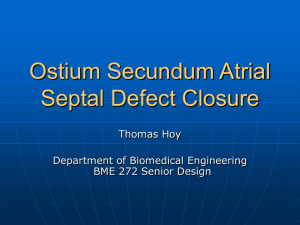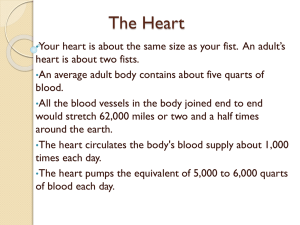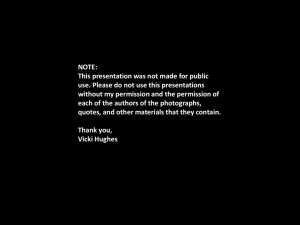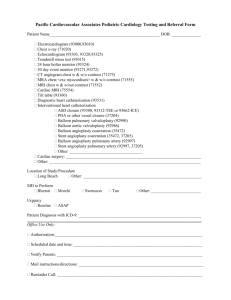Pediatric Therapeutic Catheterization Stuart Berger, M.D.
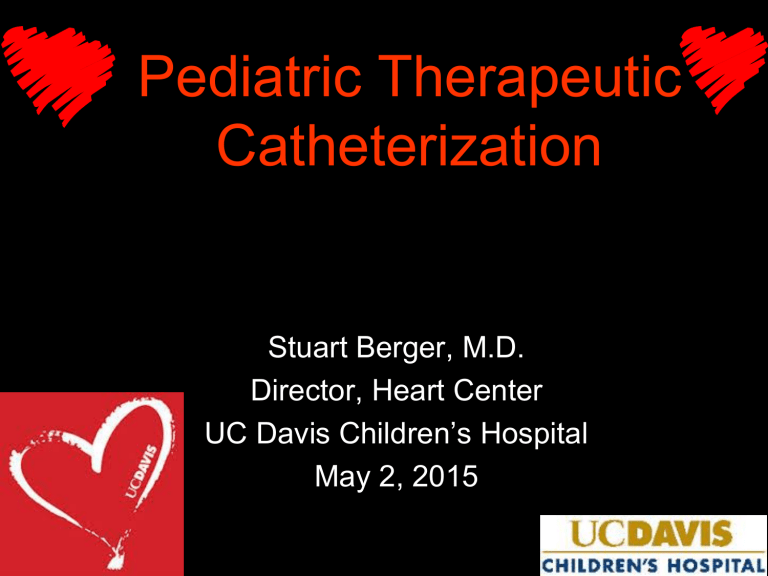
Pediatric Therapeutic
Catheterization
Stuart Berger, M.D.
Director, Heart Center
UC Davis Children’s Hospital
May 2, 2015
A Century of
Cardiology
Prostaglandins
Maude
Abbott
Robert
Gross
Balloon atrial
Septostomy
Intervention
Echocardiography
Alfred Blalock
Helen Taussig
Cardiopulmonary
Bypass
1900 1920 1940 1960 1980 2000
Children ’ s Hospital of Wisconsin
Cardiac Catheterization Laboratory
400
350
300
250
200
150
100
50
0
1993 1994 1995 1996 1997 1998 1999 2000
Diag Cath
Ther Cath
Total Caths
Therapeutic Catheterization
Balloon atrial septostomy (echo guidance)
Pulmonary and aortic valve dilatation
Arch and pulmonary artery dilatation
Stenting: pulmonary arteries/coarctation
Coil Embolization
Intravascular Devices:
Patent ductus arteriosus
Atrial septal defects
Patent foramen ovale
Ventricular septal defects
Therapeutic Catheterization
Percutaneous placement of valves
Pulmonary (Melody, others)
Aortic
Miscellaneous procedures
Balloon Atrial Septostomy
“ Creation of an Atrial Septal Defect without Thoracotomy ”
Dr. William Rashkind, Philadelphia
J.A.M.A., 1966
Head Aorta
Pulmonary artery
Lungs
Legs
Mixing sites:
Ductus arteriosus
Atrial septal defect
Ventricular septal defect
Transposition of the Great Arteries
Balloon Atrial Septostomy in Transposition of the
Great Arteries
LA
Balloon
RA
RV
LV
Balloon Valvuloplasty
“ Percutaneous Balloon Valvuloplasty:
A New Method for Treating Congenital
Pulmonary Valve Stenosis ”
Dr. Jean Kan, Baltimore
N.E.J.M, 1982
Transcatheter Balloon Valvuloplasty
The use of balloons to relieve valve obstruction
Obstructied pulmonary valve
RV
Critical Pulmonary
Valve Stenosis
Pre-dilatation
Lateral projection
Balloon guides
Transcatheter Pulmonary
Balloon Valvuloplasty
Calibration guides
Amplatz guide wire
Balloon catheter
Aortic Valvuloplasty
Results generally less predictable
Issues:
Increased risk, dysrhythmia and rupture
Aortic insufficiency
Technically, more challenging
Period of no cardiac output
The Continuum of Aortic Valve
Disease
Hypoplastic Left Heart Syndrome
“ Critical ” Neonatal Aortic Valve Stenosis
Aortic Valve Stenosis
Bicuspid Aortic Valve
Fused Trileaflet Aortic Valve
“ The worst congenital heart abnormality is aortic valve disease, because it is never cured ”
R.D.Rowe, Hospital for Sick Children
Fused
Commissure
Stenotic Trileaflet
Aortic Valve
Unicuspid Aortic Valve
Balloon Arterioplasty
“ Transluminal Treatment of
Arteriosclerotic Obstruction ”
Dr. C.T. Dotter and M.P. Judkins,
Circulation, 1964
Transcatheter Arterioplasty
Left pulmonary artery narrowing
Transcatheter Arterioplasty
Left pulmonary artery post balloon dilatation
Intravascular Stenting
Pediatric Indications:
Pulmonary arteries in pulmonary atresia
Coarctation of the aorta
Systemic veins
? Pulmonary veins
Vascular Stenting
Advantages:
Enables opening of elastic and rigid vessels
Reduced risk of vessel wall damage, dissection, rupture or aneurysm formation
Disadvantages:
Generally applicable only in older children/adults
Technically challenging to perform
Palmatz
Stent on
Balloon
Catheter
Superior vena caval obstruction
Guide wire Stent dilatation of superior vena caval obstruction
Stent
Superior vena caval obstruction relieved after stent placement
Coarctation of the Aorta
Juxtaductal Coarctation of the Aorta
Coarctation
AAo
DAo
Juxtaductal Coarctation
Palmatz stent in position
Juxtaductal Coarctation
Angiogram following relief of coarctation
OCCLUSION OF BLOOD
VESSELS
Indications for Transcatheter Occlusion
Patent ductus arteriosus
Secundum atrial septal defects
Patent foramen ovale in cryptogenic stroke patients
Fenestrated Fontan
Apical muscular VSD ’ s
Coronary-cameral fistulae
Selected aortico-pulmonary connections
Coil Embolization
Coil Embolization
Gianturco coils
RA
RV
LA
Aorta
Patent ductus arteriosus
Pulmonary artery
LV
Pulmonary artery
Aorta
Lateral angiographic view of a moderate sized patent ductus arteriosus
Delivering a
Gianturco coil
Pulmonary artery
Aorta
Delivery catheter
Antegrade approach to ductal occlusion
Amplatzer Duct
Occluder
Nitinol basket
Delivery sheath
Dacron filaments
Amplatzer Duct
Occluder
Screw-in attachment mechanism
Positioning of the Amplatzer
Ductal Occluder
Release cable
Ao
Ao
The Amplatzer
Ductal Occluder in position prior to release of the retention cable
ASD Occlusion
Atrial Septal Defects
Indications for Operative Intervention
Symptomatic congestive heart failure
Prevention of right heart volume overload and subsequent dysfunction
Pulmonary hypertension
Predisposition to pulmonary infection
Paradoxical emboli
Frequency Distribution of
Congenital Cardiac Abnormalities
Ventricular septal defects
Pulmonary valve stenosis
Atrial septal defects
Atrioventricular septal defects
Tetralogy of Fallot
D-transposition
Coarctation of the aorta
Hypoplastic left heart syndrome
Aortic stenosis
Patent ductus arteriosus
Others
32.1%
9.0%
7.7%
6.4%
6.8%
4.7%
4.6%
3.8%
2.9%
2.4%
19.6%
Atrial Septal Defects
4 sub-types
Amplatzer “ Nitinol Basket ”
Occluder Device
2 opposing flat baskets, joined by a central hub, all woven with fine Nitinol wire
Variable size connecting hub
Filled with Dacron or polyurethane strands
Potential problems :
•High profile position
•Wire exposure
Amplatzer
ASD
Device
Left Atrial Aspect
Waist
Right Atrial Aspect
Releasing
Cable
Nitinol Basket filled with
Dacron threads
Amplatzer Septal Occluder
Nitinol Basket filled with
Dacron threads
Amplatzer Septal
Occluder being extruded from sheath
right anterior
RA
LA
Ao
Color Doppler of secundum ASD
RV
Sizing the Atrial Defect
right anterior
RA
LA
Ao
RV
Amplatzer device being positioned within the atrial defect
LA
RA
Release cable
“ Minnesota Wiggle ”
right anterior
RA
LA
Ao
RV
Amplatzer device positioned and released within the atrial defect
LA right anterior
RA
Long axis view of Amplatzer device positioned within the atrial defect
SVC
AND COMING SOON!!!!
Melody Valve
The Role of RVOT Valvar
Competency
• Infant cardiac repairs benefiting from RVOT competency.
♥ Tetralogy of Fallot
♥ Pulmonary atresia with VSD
♥ Absent pulmonary valve syndrome
♥ Ross repair
♥ Truncus arteriosus
♥ DORV, TGA – Rastelli
12-15% of CHD
Conclusions
The Cath lab has become a very specialized place.
Echocardiography remains the gold standard for initial diagnosis and is integral in performance of interventional procedures.
Interventional catheterization continues to grow.
Conclusions
Current therapeutic catheterization procedures that are accepted as the standard of care :
Balloon dilation of pulmonary valve
Balloon dilation of recurrent coarctation
Balloon dilation/stenting of pulmonary arteries
Percutaneous valve placement
Conclusions
Cath procedures that are accepted as standard of care :
Stenting of recurrent coarctation
Coil occlusion of PDA
Device occlusion of PDA
Device occlusion of secundum ASD
Device occlusion of muscular VSDs
Device occlusion of PFO
